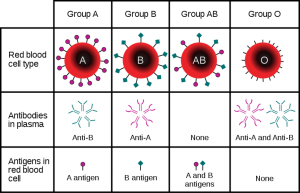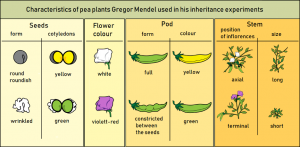By Alan Curtis
Blood type. Everybody has one. Do you know yours? We can turn to genetics to help us understand where our blood types come from. We can then use immunology to understand why blood types are important.
Gregor Mendel, the father of modern genetics, got a lot of things right with his famous pea plant experiments. We know today that our DNA is made of genes which are responsible for heritability, but we haven’t known this for very long. From 1856-1863, before ever knowing what DNA was, Mendel came to realize that some of his pea plants’ characteristics were found in their offspring, and even more striking: there was a pattern of inheritance. Based on his experiments, Mendel defined three laws of heredity.
The first of these three laws is the Law of Segregation. This law states that each parent provides one copy of a gene to their offspring. The second law, the Law of Independent Assortment, states that genes for different traits are inherited separately so that inheritance of one trait is not dependent upon another. Finally, Mendel’s Law of Dominance states an organism with alternate forms of the same gene (called an allele) will express only the dominant form while the recessive allele of the gene is silent.
The above illustration shows the traits Mendel followed in his pea plant experiments. By selectively breeding different plants together, he was able to show that traits like seed shape and color, flower color and pattern, pod shape and color, as well as plant height were controlled by heritable units he called “elements” which today we know as genes. Remember though, these experiments were published in 1865, a full 4 years before Friedrich Miescher first discovered DNA. We must also keep in mind that the structure of DNA was a mystery all the way until the 1950s after the work of Rosalind Franklin, James Watson, and Francis Crick.
This seems fairly straightforward, right? Well, sometimes genetics is more complicated, and there are scenarios in which Mendel’s laws are violated. For example, Mendel’s Law of Dominance is disobeyed in the case of blood typing, in which two dominant genes are expressed simultaneously.
There are six possible blood genotypes: AA, AB, BB, AO, BO, OO. A genotype tells us what genes the DNA holds but does not tell us which genes are expressed. Thus, there are only four blood types: A, B, AB, and O. These are called phenotypes. Blood type is dictated by 3 separate versions of the same gene: dominant A, dominant B, and the recessive O. Each person has two alleles – one from mom and one from dad. People inherit alleles and express the proteins they encode on the surfaces of their red blood cells–except the O allele, which does not produce any protein.
This is a perfect example of how one’s set of genes dictates their unique appearance. Two copies of the A gene would result in genotype AA and thus blood type A. Alternatively, you might inherit an A allele from mom and a B allele from dad, or vice versa, resulting in the AB genotype and, of course, AB blood type. You could also get an A allele from dad and an O allele from mom – an AO genotype. But remember, the O is recessive and A is dominant, which means you would still have blood type A. It’s also possible that two people with type A or type B blood (AO or BO genotype) could have a baby with type O blood if the baby inherits the O allele from each parent, creating an OO genotype. The punnett square above may help by illustrating this concept.

Now let’s talk about the “positive” and “negative” blood phenotypes. Another component of our blood phenotype is the Rhesus (or Rh) factor. The Rh factor is another protein that can be found on red blood cells and further defines our blood type. Unlike the ABO allele system, the Rh factor follows Mendel’s Third Law and is either present (Rh+) or absent (Rh-) from blood. If either parent carries the Rh gene, all offspring will possess it. For example, my full blood type is A+, just like my dad. My brother is O+. He inherited an O allele and the Rh from my dad and a second O allele from my mom, who is O-. My wife is O- as well. Two of our children are A+ while the other is O+. Can you figure out why this is? (Hint: punnett squares may be useful.)

Blood type is extremely important for blood transfusions. For example, a person with blood type A cannot receive blood from someone with type B or even AB blood. So why could I, an A+ blood type, receive blood from my wife (O-) but cannot donate to her? Our immune system is charged with two very important tasks: 1) to determine self from non-self and 2) to destroy non-self. For example, my immune system recognizes the A protein on the surface of my red blood cells as part of me and largely ignores it. My wife’s immune system, however, has never seen type A blood. So if she were to receive a transfusion of my blood, her immune system would destroy my blood cells. As the transfused red blood cells are killed by my wife’s immune system, she would sustain damage to her liver and kidneys if not treated immediately and intensively. In the modern world, this type of reaction is incredibly rare, and when it happens it’s usually due to human errors like mislabeled blood.
So the next time you donate blood, thank Gregor Mendel for discovering genetics, then think about the complex genetics and immunology behind blood types, and, most importantly, save a life in the process.
Edited by Anna Wheless and Keean Braceros


